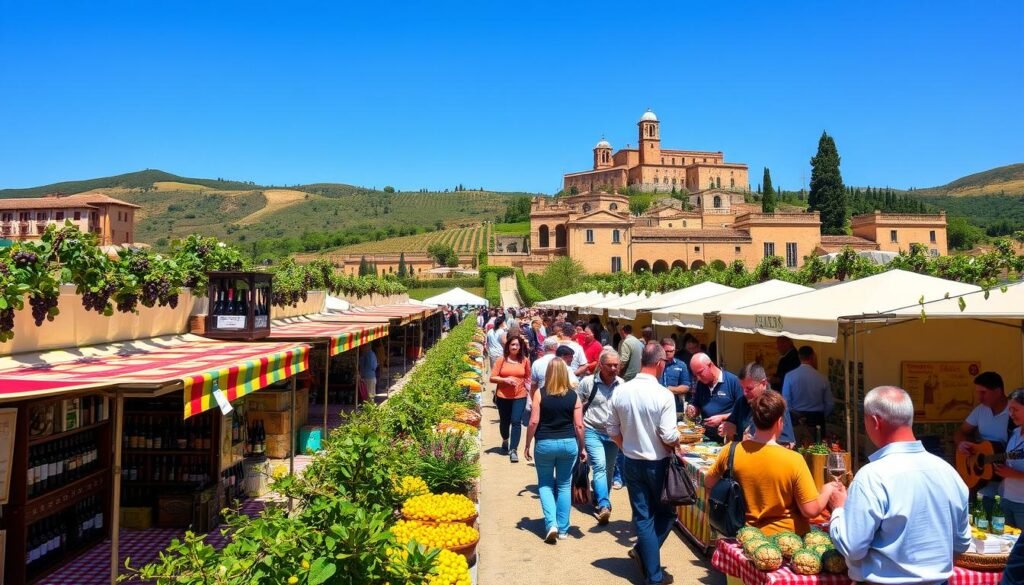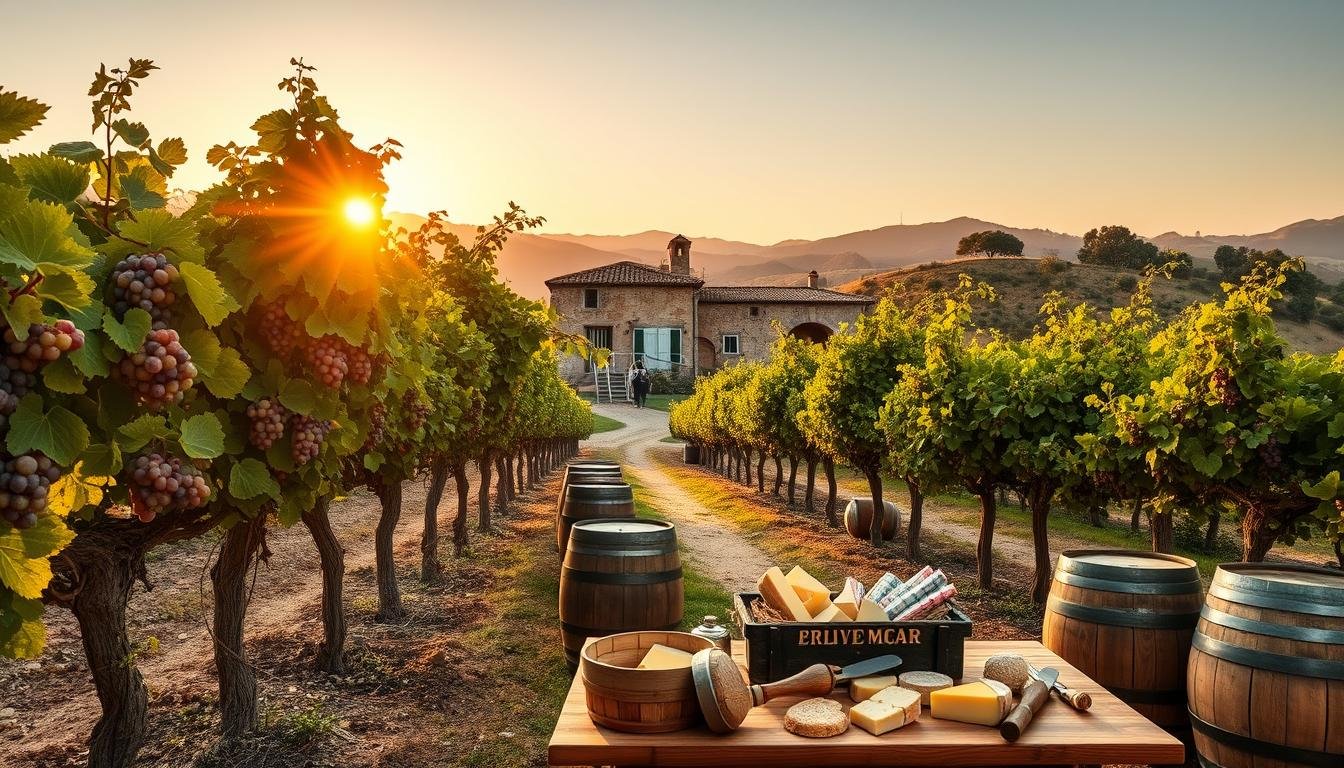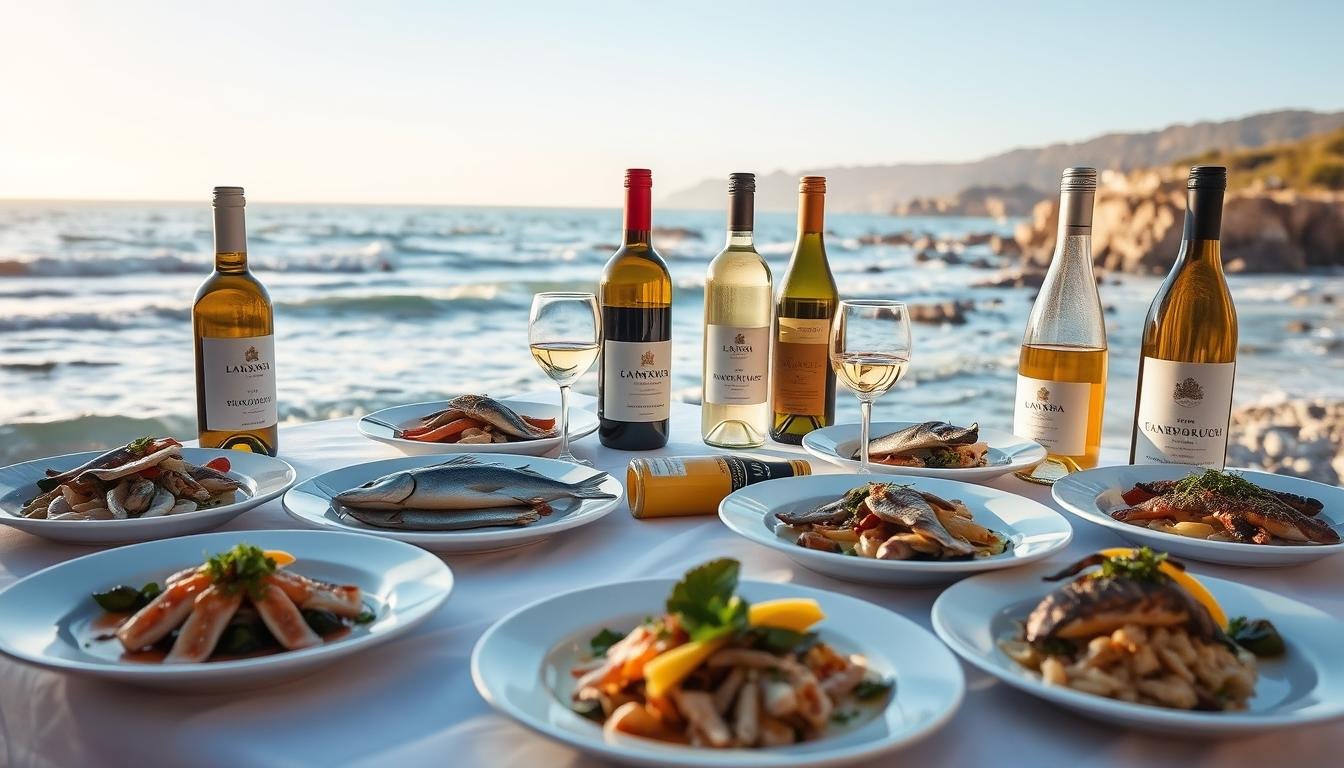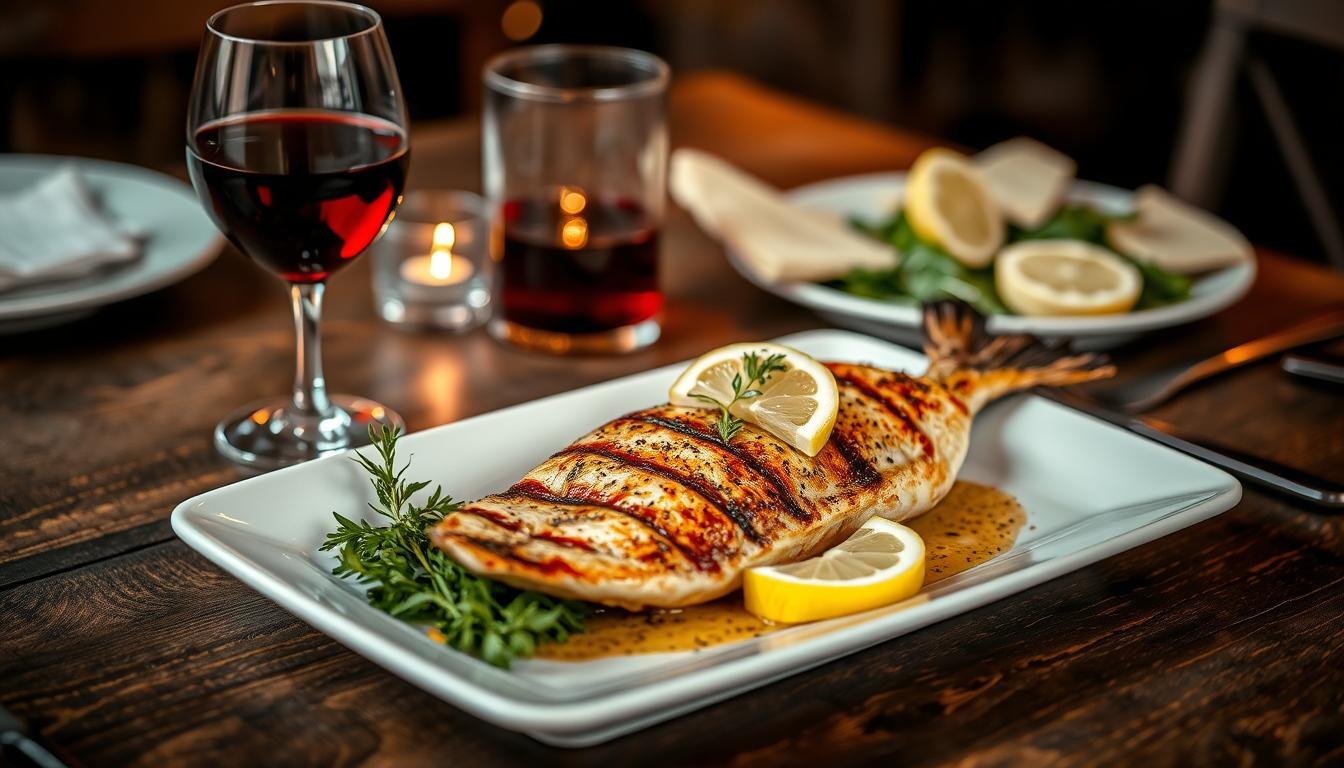Sicilian wine culture is a treasure trove of history and tradition. It has a winemaking history of over 3,000 years. Sicily’s location at the crossroads of ancient civilizations has shaped its wine culture.
The island’s wine history is influenced by Phoenicians, Greeks, and Romans. This has made Sicily’s viticulture unique and fascinating.
Exploring Sicilian wine reveals a rich history and culture. The island’s diverse landscapes produce a wide range of wines. Whether you’re a wine enthusiast or new to wine, Sicily has something for everyone.
Key Takeaways
- Sicilian winemaking dates back approximately 3,000 years, making it a historic cradle of viticulture.
- The island’s strategic location has influenced the development of its wine culture, with Phoenician, Greek, and Roman influences shaping its viticulture.
- Sicily boasts 23 DOCs and 1 DOCG, with popular red grape varieties including Nero d’Avola and Nerello Mascalese.
- The unique topography of Etna’s vineyards leads to wines with distinctive profiles due to the usage of old lava flow terraces.
- One-third of Sicilian vineyards are certified organic, reflecting the region’s commitment to sustainable winemaking practices.
- Sicilian wine culture is a treasure trove of history and tradition, with a wide range of wines that are both distinctive and delicious.
The History of Wine in Sicily
Sicily’s sicilian wine history goes back over 3,000 years. The Phoenicians first brought grapevines to the island. Later, the Greeks arrived in the 8th century BCE and improved sicilian wine traditions with their winemaking skills.
The Romans then took Sicilian wines across the Roman Empire. This showed how much people valued these wines. It was a key time in sicilian wine history.
Ancient Beginnings: Greek Influence
The Greeks brought new winemaking methods to Sicily. They made wines that were famous in the ancient world. Their impact on sicilian wine traditions is still felt today.
Roman Expansion and Wine Production
The Romans grew wine production in Sicily. They sent their wines all over their empire. This helped make sicilian wine history even more important.
Learning about Sicily’s wine history helps us appreciate its sicilian wine traditions and rich culture.
| Period | Event | Influence on Sicilian Wine |
|---|---|---|
| Phoenician | Introduction of grapevines | Marked the beginning of Sicilian wine history |
| Greek | Advanced winemaking techniques | Significantly advanced Sicilian wine traditions |
| Roman | Expansion of wine production | Contributed to the growth of Sicilian wine history and its significance in the ancient world |
Unique Terroirs of Sicily
Sicily, the largest island in the Mediterranean, has a wide range of geographical areas. Each area has its own special terroir. For over 3,000 years, sicilian wine producers have shaped the winemaking industry here. The Mediterranean climate is perfect for growing grapes, thanks to its warm summers and mild winters.
The sicilian wine regions have different soils like volcanic, limestone, clay, and sandy. For example, the volcanic soils around Mount Etna give wines a unique minerality and acidity. Coastal vineyards get sea breezes, adding complexity and freshness to their wines.
Notable sicilian wine producers include Settesoli co-op and Planeta. They have greatly contributed to Sicily’s winemaking. Here’s a table showing some key features of Sicilian wines:
| Wine Region | Soil Type | Climate |
|---|---|---|
| Mount Etna | Volcanic | Mediterranean |
| Coastal Vineyards | Clay, Sandy | Mediterranean |
In conclusion, Sicily’s unique terroirs and the skills of sicilian wine producers have created a variety of excellent wines. This makes Sicily a top spot for wine lovers to explore.
Key Grape Varieties Cultivated in Sicily
Sicily boasts a wide range of sicilian grape varieties. Each has its own special taste and traits. Nero d’Avola is the top red grape in Sicily. It’s known for making excellent wines. Sicilian wine producers focus on this grape, making it a key export.
Other important sicilian grape varieties include Frappato and white grapes like Grillo and Catarratto. Frappato is light and tastes like Pinot Noir and Gamay. Grillo is known for its zesty acidity and citrus flavors. Catarratto is a common white grape, famous for its lively acidity.

Wines like Bell’Assai Vittoria DOC Frappato from Donnafugata and Donnafugata Sur Sur Grillo Sicilia DOC are highlights. They show off the best of sicilian grape varieties. Thanks to sicilian wine producers, these wines are getting noticed worldwide.
Traditional vs. Modern Winemaking Techniques
Sicilian wine producers have a long history, dating back over 3,000 years. The island’s terroir and Mediterranean climate are perfect for growing grapes. This leads to a wide variety of wines.
Traditionally, Sicilians use local grape varieties like Nero d’Avola and Frappato. These grapes thrive in the island’s climate and soil.
Now, many producers are using modern techniques like biodynamic and organic winemaking. These methods help make better, more sustainable wines. They use natural ways to fight pests and diseases and improve soil health.
Producers are also using new technology to manage vineyards better. This includes monitoring conditions and reducing environmental impact. These steps improve wine quality and make winemaking more eco-friendly.
The Influence of Sicily’s Volcanic Soil
Exploring Sicilian wines reveals the island’s volcanic soil’s impact. Mount Etna’s soil is especially notable for its quality wines. The soil’s potassium and magnesium, along with the area’s temperature changes, enhance grape acidity and aroma.
The volcanic soil around Mount Etna is home to top sicilian wine producers like Planeta and Tasca d’Almerita. They export their wines to the U.S., where they’re recognized for their unique flavors. The sicilian wine regions around Mount Etna have diverse climates and altitudes. This leads to wines with distinct flavors.
Some key characteristics of Mount Etna wines include:
- High acidity levels
- Unique flavor profiles, with notes of minerality and elegance
- Aging potential, with some wines capable of aging for 10-15 years or more
The volcanic soil and climate of Mount Etna make it perfect for quality wines. Exploring sicilian wine producers and sicilian wine regions reveals a variety of wines. These showcase the region’s unique terroir and winemaking traditions.
| Wine Producer | Wine Region | Notable Wines |
|---|---|---|
| Planeta | Mount Etna | Carricante, Nerello Mascalese |
| Tornatore | Mount Etna | Carricante, Nerello Mascalese |
| Benanti | Mount Etna | Carricante, Nerello Mascalese |
Sicilian Wine and Food Pairing
Exploring sicilian wine culture means looking at food pairing. Sicilian wine tourism shows how local wines pair well with traditional dishes. The island’s unique terroir and climate give its wines distinct flavors, perfect for Sicilian cuisine.
Try pairing Nero d’Avola with pasta con le sarde for a great taste. The wine’s flavors match the sardines’ sweetness, creating a perfect balance. For dessert, Passito di Pantelleria, made from Zibibbo grapes, pairs well with cannoli.
Here are some tips for perfect pairings:
- Pair sweet wines like Marsala with desserts or sweet dishes
- Match white wines like Grillo with seafood or salads
- Combine red wines like Nero d’Avola with meat or pasta dishes
Exploring sicilian wine tourism and pairing local wines with dishes deepens your appreciation. Whether visiting the island or trying wines at home, wine and food pairing makes the experience better.
Notable Sicilian Wine Regions
Exploring Sicilian wine regions reveals a variety of terroirs and wine styles. For centuries, Sicilian wine producers have honed their skills. This has led to a wide range of high-quality wines.
Mount Etna’s volcanic soils and the Mediterranean’s coastal vineyards each offer a unique perspective. Cerasuolo di Vittoria is known for its Nero d’Avola and Frappato grapes. Etna Wine benefits from Mount Etna’s high altitude and volcanic soil.
The Val di Noto is a UNESCO World Heritage site. The Aeolian Islands have distinct wines on each of their seven islands. These regions are worth exploring.
Visiting these regions lets you experience the rich history and culture of wine production. Wineries like Tornatore and Benanti offer private tastings and tours. They give a glimpse into the world of Sicilian wine producers.
| Region | Notable Grapes | Wine Style |
|---|---|---|
| Cerasuolo di Vittoria | Nero d’Avola, Frappato | Full-bodied, fruity |
| Etna Wine | Nerello Mascalese | Light-bodied, minerally |
| Val di Noto | Nero d’Avola, Syrah | Full-bodied, spicy |
The Rise of Sicilian Wine in the Global Market
Have you noticed Sicilian wines becoming more popular? This is thanks to Sicilian winemakers and the special Sicilian wine culture. They focus on local grapes and old winemaking ways, making Sicilian wines famous worldwide.
Recent numbers show Sicilian red wines were exported for 74 million euros, and white wines for 41 million euros. This shows more people want to try Sicilian wine tourism. You can learn more by visiting Sicilian wine websites and reading about others’ experiences.
Here are some key points about Sicilian wine’s growth:
- Exports of Sicilian PDO white wines rose by 29% in the United States, 13.9% in Canada, and 6.8% in Germany.
- The average value of Sicilian PDO white wines increased by 29.6% from 3.14 euros per liter in 2018 to 4.07 euros per liter in 2023.
- Sales of regional PDO wines grew by 5.3% in value in large-scale organized distribution, outperforming the national average of 3.4%.
Sicilian wine producers are ready to meet the growing demand for quality wines. With its rich Sicilian wine culture and beautiful landscapes, Sicily is a top spot for Sicilian wine tourism. Whether you love wine or are just starting to explore, Sicily is a must-see.
Wine Festivals and Events in Sicily
Sicily is famous for its lively wine culture. Attending a sicilian wine festival is a great way to see it. These events highlight the region’s wine history and let you try many sicilian wines. From the Sicily Wine Festival to the Etna Wine Festival, there’s always something happening.
The Festa di Sant’Agata in Catania draws over 1 million people each year. The Infiorata di Noto features beautiful flower carpets made by artists. The Sagra del Mandorlo in Fiore celebrates almond trees in early March.

These festivals are perfect for experiencing sicilian wine culture. You can meet local winemakers and learn how wine is made. Whether you love wine or just want a unique experience, don’t miss a sicilian wine festival.
| Festival | Date | Location |
|---|---|---|
| Festa di Sant’Agata | February 3-5, 2025 | Catania |
| Infiorata di Noto | May 17-19, 2025 | Noto |
| Sagra del Mandorlo in Fiore | March 1-10, 2025 | Fiore |
How to Experience Sicilian Wine Culture
Exploring sicilian wine tourism opens a world of rich wine culture over 3,000 years old. To really get into it, visit wineries and vineyards. There, you can learn about how they make wine in Sicily.
Here are some ways to dive into sicilian wine culture:
- Guided wine tours, which offer a deep dive into wine-making
- Self-driving tours, letting you explore at your own speed
- Wine tastings, where you can try top Sicilian wines
By joining in on sicilian wine tourism, you learn about wine culture. You also help the local economy and keep traditional winemaking alive. So, start planning your Sicily trip today and see the beauty of sicilian wine culture for yourself.
| Wine Region | Notable Wines | Wine Tours |
|---|---|---|
| Marsala | Marsala wine | Guided tours available |
| Mount Etna | Nerello Mascalese | Self-driving tours available |
| Vittoria | Cerasuolo di Vittoria | Wine tastings available |
Resources for Exploring Sicilian Wines
Exploring Sicilian wine culture is exciting and easy with many resources available. You can find local wine shops and online communities to help you. Sicilian wine tourism is growing, making it easier to taste these unique wines.
Looking for Sicilian wines locally? Check out specialty wine stores or Italian markets. They often have a wide selection of Sicilian wines. Join online communities and wine clubs for a deeper dive into Sicilian wine culture. You’ll meet other wine lovers and learn about new wines.
Online Communities and Wine Clubs
Online platforms are full of useful information. You can find wine reviews, tasting notes, and recommendations. Joining these communities helps you learn more about Sicilian wines and stay current with the latest trends.









